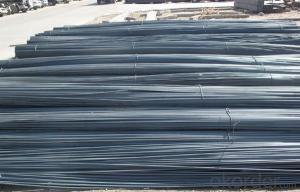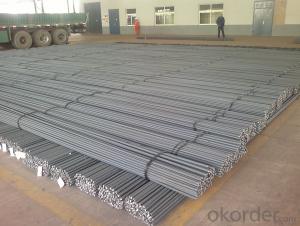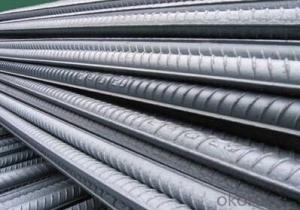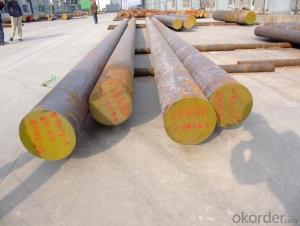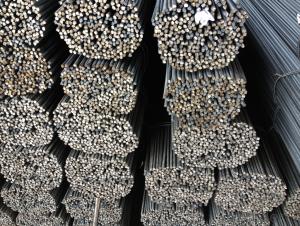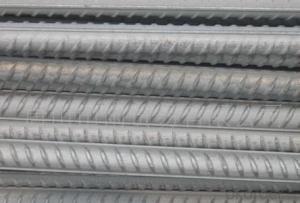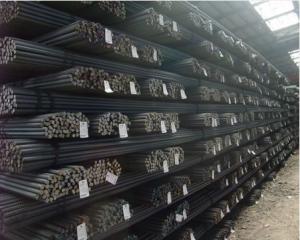Deformed iron rods for construction building
- Loading Port:
- Tianjin
- Payment Terms:
- TT OR LC
- Min Order Qty:
- 1000 m.t.
- Supply Capability:
- 17497 m.t./month
OKorder Service Pledge
OKorder Financial Service
You Might Also Like
Specification
steel rebar is metal bars often used in construction for pouring concrete or supporting walls and columns. The
rebar can be smooth, though they are frequently manufactured with deformations that create greater texture to
which concrete can adhere, creating a stronger bond that helps prevent cracking of concrete. These deformations
do not create weaknesses in the rebar, and when rebar is measured to determine its diameter, it is typically measured
at the narrowest point. Strength grades indicate the amount of pressure the steel rebar can withstand, and grade and
diameter are typically presented in both imperial and metric units
Product Description :
Chemical composition (%): | Steel | C | Si | Mn | P | S | Ceq | ||||
HRB335 |
0.25 |
0.80 |
1.60 |
0.045 |
0.045 | 0.52 | |||||
HRB400 | 0.54 | ||||||||||
HRB500 | 0.55 | ||||||||||
Mechanical properties | Steel | Rel/ MPa | Rm/ MPa | A/ % | Agt/ % | ||||||
≥ | |||||||||||
HRB335 | 335 | 455 | 17 |
7.5 | |||||||
HRB400 | 400 | 540 | 16 | ||||||||
HRB500 | 500 | 630 | 15 | ||||||||
Package: | Standard export packing or as customer's request | ||||||||||
Application: | Construction, building, bridge, road. ect | ||||||||||
Payment terms | 1).100% irrevocable L/C at sight. | ||||||||||
Delivery time | 15-30 days after receipt of L/C or deposit by T/T | ||||||||||
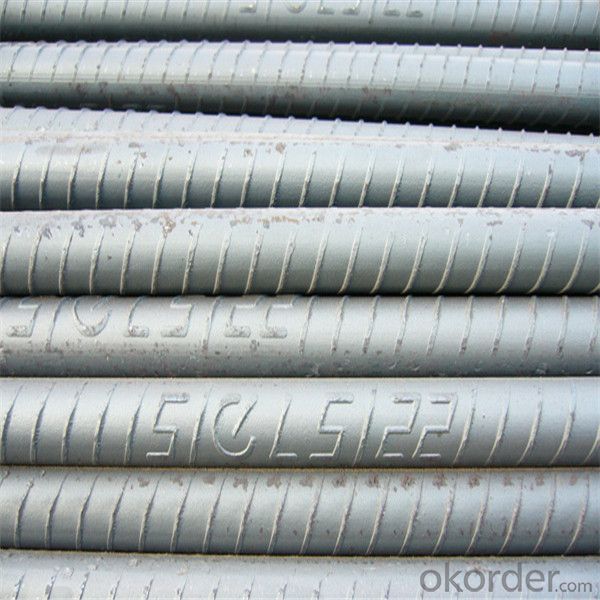
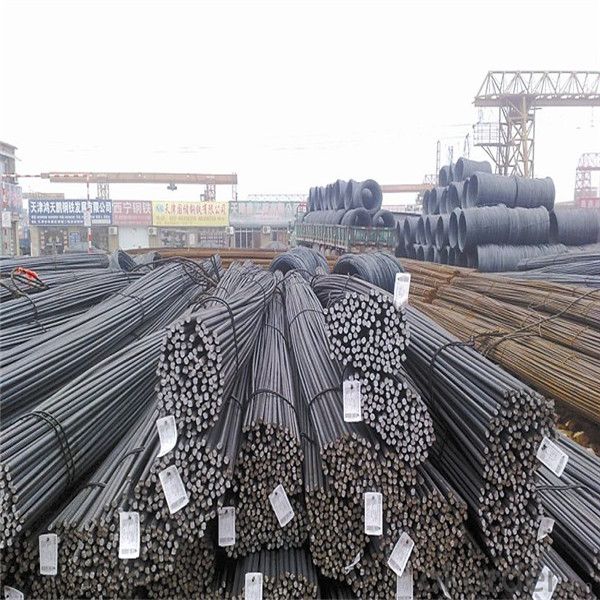
Features
1、Pure steel quality, stable chemical contents, small tolerance.
2、Constant Quality, good drawing performance.
3、High dimension accuracy degree, accuracy degree of Level C up to 80%, smooth surface, less scale, easy to be pickled.
4、Automatic bundling with 4 lines by Machine in tidy and good looks
5、Big high quality percentage, small coil percentage, and heavy coil weight for Hard Coil.
6、High sorbitizing percentage.
Packing:
In bundles, each bundle weight 3.5 tons. Load by container or by bulk verssel.

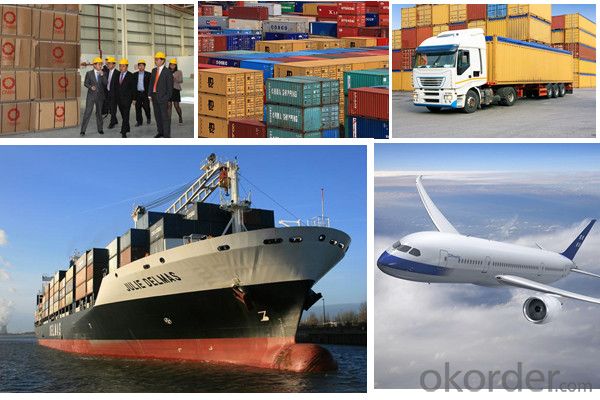
FAQ:
1.Q: What's your MOQ(minimum order quantity)?
A: One full container, mixed acceptable .
2. Q: What's your packing methods?
A: Packed in bundle or bulk ..
3. Q: How can I buy CNBM products in my country?
A:Please send us an inquiry or email ,we will reply to you if there is distributor in your country
4. Q: Can we visit your factory?
A: Warmly welcome. Once we have your schedule, we will arrange the professional sales team to follow up your case.
5. Q: How long does it take to get the product if i place an order?
A:With the process of your requirements,we will pack and deliver in 3-7 days. If it is by sea shipment,it will take 15-45 days depending on different locations
- Q: How are steel rebars installed in construction projects?
- Steel rebars play a vital role in reinforced concrete structures in construction projects. The installation process of these rebars encompasses several steps. To begin with, the construction plans and specifications are thoroughly examined to determine the required size, length, and placement of the rebars. This information is crucial to guarantee that the rebars provide the necessary strength and support to the structure. Subsequently, the rebars are cut and shaped according to the specifications. This is typically accomplished using specialized tools like rebar cutters and benders. The rebars are generally supplied in lengthy pieces and are cut to the desired size on-site. Once the rebars are prepared, they are positioned and firmly secured in the formwork or molds that will shape the concrete. This is achieved by placing the rebars in the desired locations and using wire or rebar ties to hold them in place. The ties are typically twisted around the rebars using pliers or a similar tool. This ensures that the rebars maintain their correct positions during the pouring and curing of the concrete. During the pouring phase of the concrete, the rebars are meticulously positioned to ensure even distribution and adequate spacing. This is crucial for providing structural integrity and preventing the formation of weak spots in the concrete. After the concrete is poured, it is left to cure and harden. During this period, the rebars become embedded within the concrete, establishing a strong bond. This bond creates a reinforced concrete structure capable of withstanding various loads and forces. To summarize, the process of installing steel rebars in construction projects involves cutting and shaping the rebars, accurately positioning them within the formwork, and securing them in place using ties. This process is critical for creating durable and robust reinforced concrete structures.
- Q: Can steel rebars be painted or coated for aesthetic purposes?
- Yes, steel rebars can be painted or coated for aesthetic purposes. The paint or coating helps enhance the appearance of the rebars and can also provide additional protection against corrosion.
- Q: Can steel rebars be used in structures with high resistance to vibration?
- Yes, steel rebars can be used in structures with high resistance to vibration. Steel rebars are commonly used as reinforcement in concrete structures to increase their strength and durability. The use of steel rebars enhances the structural integrity of a building or infrastructure, making it more resistant to various forces, including vibrations. Steel rebars possess excellent tensile strength and stiffness, which allows them to absorb and distribute the applied loads evenly throughout the structure. This property helps to minimize localized stress concentrations that could lead to vibrations or structural failure. Additionally, steel rebars can effectively control the crack widths and prevent the propagation of cracks, further enhancing the structure's resistance to vibrations. Moreover, steel rebars can be designed to meet specific requirements based on the expected vibration levels. By utilizing rebars with appropriate diameters, spacing, and anchorage details, the structure can be engineered to withstand vibrations caused by various external factors, such as earthquakes, wind loads, or nearby machinery. It is crucial to ensure proper design and detailing of steel rebars in structures with high resistance to vibration. The reinforcement layout should be carefully planned to account for the anticipated forces and vibrations. Additionally, the rebars should be adequately anchored and connected to other structural members to maintain their effectiveness in resisting vibrations. Overall, steel rebars are a reliable and widely-used reinforcement material that can significantly enhance the resistance of structures to vibrations when designed and implemented correctly.
- Q: How are steel rebars used in the construction of dams?
- The construction of dams relies heavily on steel rebars, as they offer the necessary strength and stability to the structure. Dams, which are massive concrete constructions designed to contain water for various purposes like hydroelectric power generation, irrigation, and flood control, greatly benefit from the presence of steel rebars. Steel rebars, also referred to as reinforcing bars, are essential in reinforcing the concrete and enhancing its ability to withstand tension. Although concrete is excellent at withstanding compression, it is relatively weak when it comes to tension. This is where steel rebars come into play, as they are strategically positioned inside the concrete structure to counteract any tensile forces that may lead to cracks or failure. Typically, in the construction of dams, steel rebars are embedded within the concrete in a crisscross manner, forming a network of reinforcement. This configuration helps to evenly distribute the load and resist the immense pressure exerted by the water behind the dam. By reinforcing the concrete, steel rebars ensure that the dam can withstand various forces, including the weight of the water, water pressure, and external factors such as earthquakes. Moreover, steel rebars also serve to prevent cracks from spreading within the concrete. In the event of minor cracks caused by environmental factors or settlement, the rebars act as a barrier, preventing the cracks from expanding and compromising the structural integrity of the dam. To ensure their strength and durability, steel rebars used in dam construction must meet specific standards and specifications. Typically, they are made from high-strength steel capable of withstanding the immense pressures and forces encountered during dam construction. In conclusion, the presence of steel rebars is vital in the construction of dams as they reinforce the concrete, provide the necessary strength and stability, and prevent the propagation of cracks. Their strategic placement and configuration aid in load distribution, tension resistance, and the maintenance of the dam's structural integrity and reliability.
- Q: What are the different types of couplers used for connecting steel rebars?
- There are several types of couplers used for connecting steel rebars, including mechanical couplers, welded couplers, and grouted couplers. Mechanical couplers utilize threaded or tapered designs to connect rebars, providing a strong and reliable joint. Welded couplers involve welding the rebars together, creating a permanent connection. Grouted couplers use a combination of grout and mechanical means to connect rebars, offering both load-bearing capacity and corrosion protection. The choice of coupler type depends on various factors such as project requirements, rebar diameter, and structural design.
- Q: How are steel rebars measured and priced?
- Steel rebars are priced and measured based on their length and weight, with weight typically measured in pounds or kilograms and length in feet or meters. The weight of a rebar is determined by its diameter, commonly gauged in millimeters or inches. To determine the cost of a steel rebar, the weight is multiplied by the cost per unit weight, which may differ depending on factors such as the steel type, market demand, and supplier. This cost is generally quoted in terms of cost per pound or cost per kilogram. Besides weight and length, other factors like steel grade, manufacturing process, and any additional treatments or coatings applied to the rebar can also impact pricing. It is crucial to note that steel rebar prices can vary among suppliers. Thus, it is advisable to obtain multiple quotes and compare them before making a purchasing decision.
- Q: What is the standard size of a steel rebar?
- The standard size of a steel rebar typically ranges from 6mm to 50mm in diameter.
- Q: What are the different types of coating available for steel rebars?
- There are several different types of coatings available for steel rebars, including epoxy coating, galvanized coating, and polyethylene coating. Epoxy coating provides corrosion resistance and is often used in environments where the rebar is exposed to moisture or chemicals. Galvanized coating involves applying a layer of zinc to the rebar's surface, which helps to prevent rust and corrosion. Polyethylene coating is a plastic coating that provides additional protection against corrosion and is commonly used in concrete structures.
- Q: What is the role of steel rebars in preventing structural collapse?
- The prevention of structural collapse is a crucial role played by steel rebars, as they reinforce concrete structures. While concrete is strong in compression, it lacks strength in tension. This is where steel rebars come into play, effectively enhancing the tensile strength of the concrete. When a building or any concrete structure is subjected to structural loads, the rebars distribute the load across a wider area. This prevents the concrete from cracking and failing under stress. By providing a means for the concrete to resist tension and bending forces, steel rebars help maintain the integrity and stability of the structure. In addition to improving tensile strength, rebars also increase the overall ductility and flexibility of the concrete. This is especially important during events like earthquakes or high winds, as structures must withstand significant lateral forces. The presence of rebars allows the concrete to absorb and dissipate these forces, reducing the risk of structural failure. Furthermore, steel rebars play a role in preventing structural collapse by resisting the effects of corrosion. When embedded in concrete, the rebars are shielded from moisture and other corrosive elements. This ensures their long-term durability and ability to support the structure. To summarize, steel rebars are essential components in preventing structural collapse. They reinforce concrete structures, enhance tensile strength, improve ductility, resist corrosion, and ultimately contribute to the overall safety and stability of buildings and other concrete constructions.
- Q: How do steel rebars contribute to the overall sustainability of the construction industry?
- The construction industry benefits from steel rebars in several ways, which contribute to its overall sustainability. To begin with, the utilization of steel rebars improves the strength and longevity of concrete structures. This leads to reduced repair and replacement needs, resulting in less construction waste and a smaller environmental impact. Furthermore, steel rebars can be recycled and repurposed at the end of their life cycle. This not only decreases the demand for new steel production but also reduces energy consumption and greenhouse gas emissions associated with manufacturing. By embracing the circular economy, steel rebars help conserve natural resources and decrease the construction industry's carbon footprint. Moreover, incorporating steel rebars into concrete structures enhances their ability to withstand seismic activity and extreme weather conditions like hurricanes or earthquakes. This ensures the safety of occupants and minimizes the risk of infrastructure damage, thereby reducing the need for reconstruction and increasing overall resilience. Additionally, steel rebars can be engineered to optimize material usage and decrease the weight of structures. This leads to more efficient transportation and installation processes, resulting in lower fuel consumption and emissions related to transportation. Lastly, steel rebars offer flexibility in design and construction, enabling innovative and sustainable building solutions. They can easily be integrated into various construction methods, allowing for the use of sustainable techniques such as prefabrication or modular construction. This improves efficiency, reduces construction time, and minimizes disruption to the surrounding environment. In conclusion, steel rebars are essential for the sustainability of the construction industry. They enhance structure durability, promote recycling, reduce waste generation, conserve resources, improve safety, and enable innovative construction techniques. Their use contributes to the overall environmental, social, and economic sustainability of the industry, making them a vital component in sustainable construction practices.
Send your message to us
Deformed iron rods for construction building
- Loading Port:
- Tianjin
- Payment Terms:
- TT OR LC
- Min Order Qty:
- 1000 m.t.
- Supply Capability:
- 17497 m.t./month
OKorder Service Pledge
OKorder Financial Service
Similar products
Hot products
Hot Searches
Related keywords













